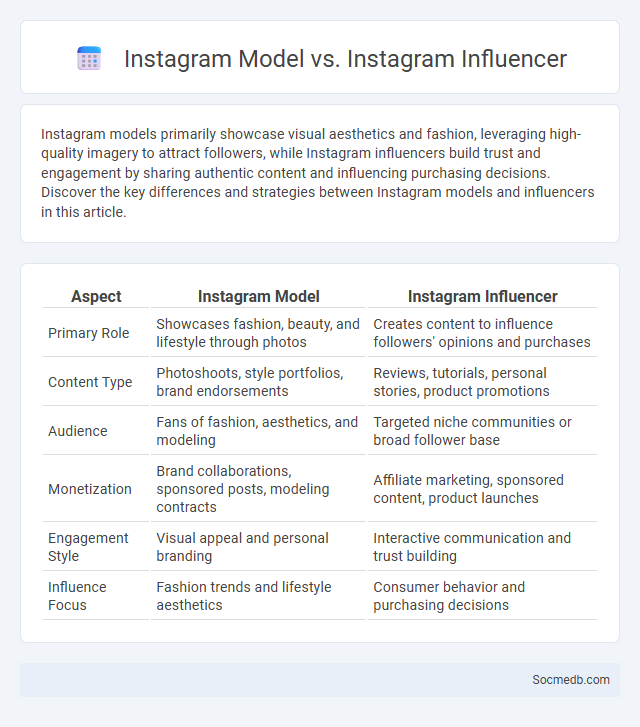
Photo illustration: Instagram Model vs Instagram Influencer
Instagram models primarily showcase visual aesthetics and fashion, leveraging high-quality imagery to attract followers, while Instagram influencers build trust and engagement by sharing authentic content and influencing purchasing decisions. Discover the key differences and strategies between Instagram models and influencers in this article.
Table of Comparison
| Aspect | Instagram Model | Instagram Influencer |
|---|---|---|
| Primary Role | Showcases fashion, beauty, and lifestyle through photos | Creates content to influence followers' opinions and purchases |
| Content Type | Photoshoots, style portfolios, brand endorsements | Reviews, tutorials, personal stories, product promotions |
| Audience | Fans of fashion, aesthetics, and modeling | Targeted niche communities or broad follower base |
| Monetization | Brand collaborations, sponsored posts, modeling contracts | Affiliate marketing, sponsored content, product launches |
| Engagement Style | Visual appeal and personal branding | Interactive communication and trust building |
| Influence Focus | Fashion trends and lifestyle aesthetics | Consumer behavior and purchasing decisions |
Understanding Instagram Models: Definition and Roles
Instagram models are individuals who leverage the platform to showcase fashion, lifestyle, and beauty content, influencing followers through curated visual storytelling. Their roles extend beyond posting images to include brand collaborations, promoting products, and shaping consumer trends by engaging with diverse audiences. Understanding Instagram models involves recognizing their impact on digital marketing, social influence, and the evolving dynamics of social media branding.
Who Is an Instagram Influencer?
An Instagram influencer is an individual who has built a significant following by consistently sharing engaging content, often centered around lifestyle, fashion, travel, or niche interests, and holds the power to affect their audience's purchasing decisions. Brands collaborate with Instagram influencers to leverage their credibility and reach for targeted marketing campaigns, driving brand awareness and sales. The effectiveness of an Instagram influencer is measured by parameters like follower count, engagement rate, and audience demographics.
What Does "Influencer" Actually Mean Today?
An influencer today refers to an individual who leverages large social media followings to shape opinions, trends, and consumer behavior across platforms like Instagram, TikTok, and YouTube. These creators generate authentic content that fosters engagement, establishes credibility within niche communities, and often partners with brands for targeted marketing campaigns. The evolving definition also encompasses micro-influencers, who command smaller but highly loyal and interactive audiences, making them valuable for precise, impact-driven digital strategies.
Key Differences Between Instagram Models and Influencers
Instagram models primarily focus on visual content showcasing fashion, beauty, or lifestyle, often emphasizing aesthetics and personal branding through professional photography. Influencers engage more actively with their audience by sharing authentic experiences, opinions, and recommendations across various content formats to build trust and foster community interaction. Your choice between collaborating with an Instagram model or influencer depends on whether you seek visually striking promotion or genuine audience engagement.
Content Strategies: Models vs Influencers vs General Influencers
Content strategies on social media differ significantly between models, influencers, and general influencers, each targeting distinct audience engagements and brand goals. Models often leverage visual storytelling and high-quality imagery to enhance personal branding and attract fashion or lifestyle partnerships, emphasizing aesthetics and aspirational content. Influencers and general influencers prioritize diverse content formats such as tutorials, reviews, and interactive posts, aiming to foster community trust and drive conversions through relatability and authenticity.
Audience Engagement: How Each Group Connects with Followers
Different social media platforms foster audience engagement through unique interaction styles tailored to their user base; Instagram leverages visual storytelling and influencer collaborations to boost connection, while Twitter emphasizes real-time conversations and trending topics for immediate engagement. Facebook groups and pages encourage community building through shared interests, allowing brands and creators to cultivate loyal followers with targeted content and direct communication. TikTok's algorithm-driven content discovery promotes viral engagement by connecting creators with a broad, active audience through short, compelling videos that encourage comments, shares, and challenges.
Brand Collaborations: Models vs Influencers Approaches
Brand collaborations with models often emphasize polished aesthetics and professional presentation, leveraging their runway experience and visual appeal to enhance luxury and fashion campaigns. Influencers bring authentic engagement and trust from niche online communities, driving higher interaction rates and targeted audience reach through personalized storytelling. Combining models' high-fashion credibility with influencers' relatability can optimize brand impact across diverse consumer segments.
Revenue Streams and Monetization Opportunities
Social media platforms generate substantial revenue through diversified streams such as advertising, sponsored content, and subscription services. Key monetization opportunities include targeted ads leveraging user data, influencer partnerships driving brand promotions, and premium features like exclusive content or ad-free experiences. Expanding e-commerce integrations and virtual goods sales further enhance revenue potential within social media ecosystems.
Choosing the Right Path: Becoming a Model or Influencer
Choosing the right path between becoming a model or influencer depends on your strengths and goals in social media branding. Models excel in visual storytelling and often work with fashion and lifestyle brands, while influencers build personal connections through authentic content and audience engagement. Understanding your unique style and audience preferences helps you tailor your content to grow your presence effectively.
Future Trends: The Evolution of Influencer Marketing on Instagram
Instagram's influencer marketing is poised to evolve with the integration of augmented reality (AR) and artificial intelligence (AI), enhancing user engagement through immersive shopping experiences and personalized content. Micro and nano-influencers will gain prominence due to their higher engagement rates and authenticity, driving more niche and targeted marketing campaigns. Brands are increasingly leveraging data analytics and influencer performance metrics to optimize ROI and foster long-term partnerships in an ever-competitive digital landscape.
 socmedb.com
socmedb.com